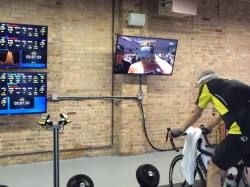When you first began training, you likely experienced rapid and seemingly unending development as an athlete. However, if you’ve been at it for a few years, you may have noticed that these gains have leveled off and your race results have been pretty similar over the past few seasons. You may be wondering what the magic formula is or what untapped source of improvement may still be available for you to exploit. Unfortunately, the truth is you may have reached your physiological potential and there may not be much room left for actual growth in your energy systems. Even at the highest levels of sport, the actual differences in fitness and power between elite competitors are marginal. The answer to improved performance is designing a training plan so that you can optimize the fitness and skills that you have worked so diligently to develop at the most opportune time…also referred to as “peaking”.
The idea behind peaking is a gradual reduction in training load that emphasizes the positive aspects of training (fitness) while simultaneously minimizing the negative effects (fatigue), such that performance is maximized. Although the rationale can be explained rather simply, in practice designing an effective peaking strategy is as much art as it is science. What works for one athlete may not be effective or appropriate for another athlete with different goals or life situations. Technology such as Peaksware’s WKO+ performance manager can help to shed light on one’s training state, but it is important to remember that such models tell the truth mathematically, but cannot account for life’s intangibles. Experimentation with different approaches is the only way to truly determine your own best strategy.
Athletes will also do well to give careful thought to what events they want to peak for. Think of the peak as a financial transaction. By reducing training load, you are investing your “fitness” in the hopes of reaping a worthwhile return in “freshness”. The key tipping point is to make sure you don’t give up so much fitness that you aren’t able to take advantage of your new-found freshness. That would be like investing everything you have in your retirement fund, but leaving yourself without the means to support yourself until retirement! And just like your retirement fund, these performance gains don’t last forever. Most athletes can realistically peak twice a year, with the first peak usually being larger and more sustained.
As mentioned above, peaking may not make the most sense for athletes within the first year or two of training. They are still on a very rapid growth curve and will likely reach better, long-term performance through continued focus on improving their fitness. For more experienced athletes who may see a peaking strategy as appropriate, the temptation may be to peak for the highest profile event on your race calendar. But it is also necessary to weigh the expected outcome of the peak against your ambitions for the goal event. In timed events where you are looking for a PR finish, a well planned peak can work wonders. On the other hand, if your goal will feature a mass start or a very competitive field; don’t expect even the best taper to put you in the money unless you’ve previously proven that you can compete on that level. Instead, your investment may be better spent on a smaller event where the results of your peak can put you in a position to win.
Two of the most important factors to account for when designing a peak are the composition of past training and the nature of the goal event. If cumulative training load has not been very high, and consequently your body is not very tired, the time from reduction in training load to peak performance may not be long, perhaps a week or even less. On the other hand, if training load has been high, as well as the resultant fatigue, it may take up to a month to reach your best from the time of the initial reduction in workload. Related to the reductions in load is the make-up of the remaining work. Your training during the peaking phase should be as specific as possible to the upcoming event. Load can be reduced by decreasing volume or decreasing intensity, thus for longer events, such as centuries and half or full Ironman triathlons, it makes more sense to maintain training volume but keep the intensity very low. For short, explosive events such as track cycling, road racing and Olympic and short triathlons, it is essential to maintain some intensity in training, but a good deal of the training volume should be removed.
Both training and rest compose essential parts of our training plan. Reaching our best performances requires the optimal interaction of both so that we don’t arrive at goal events either overtired or underfit. To sum it up as only he can, Team RadioShack physiologist, Dr. Allen Lim, states, “Training is like baking a hot apple pie. Peaking is letting it cool off before you eat it. ‘Cause it really sucks to burn yourself on something so good.”
Here’s to being at your best at your peak-worthy races this season!

